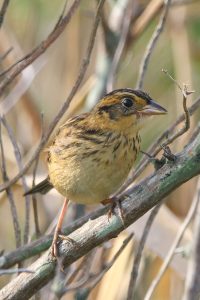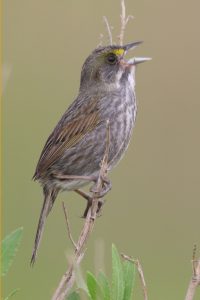by Sam Collins, Research Scientist
New Jersey’s coastal nesting birds have lost a substantial amount of habitat due to dense development – and sea level rise, sinking marshes, increased storm intensity, and flood frequency threaten what remains. As available marsh habitat sheltered from frequent flooding continues to disappear, identifying important nesting areas and understanding the factors that affect populations of saltmarsh breeding birds are essential to protect or improve habitat for these sensitive species.

Saltmarsh Sparrow
During the 2022 nesting season, scientists at The Wetlands Institute (TWI) investigated habitat use, choice of nest sites, and reproductive success of Saltmarsh Sparrows and Seaside Sparrows (both highly secretive marsh nesting birds) in coastal wetlands within the Seven Mile Island Innovation Laboratory study area. Saltmarsh Sparrows are declining significantly, with an estimated nine percent population loss species-wide each year, prompting its consideration for federal listing as an endangered species. Seaside Sparrow population trends are not well understood.
Through the use of acoustic monitoring devices and direct surveys of specific key marsh sites, we explored where these species occurred and where they chose to nest within restored and natural marsh areas.

Seaside Sparrow
According to our initial results, these birds preferred to nest in marsh areas on or directly adjacent to historic dredge placement sites. These areas offered both higher elevation and vegetation the birds preferred, though flooding still occurred at several of the nests we monitored. We did identify a key nesting area on Gull Island that provided suitable habitat to allow both Saltmarsh and Seaside Sparrows to fledge young. However, as with other study areas, certain nests within this area were vulnerable to flooding, depending on the exact nest location and changes in water elevation. As we continue our work, results from our ongoing efforts will help provide recommendations for continued maintenance and monitoring, and guide considerations for future project development related to beneficial use of dredged materials to assist these at-risk species.


